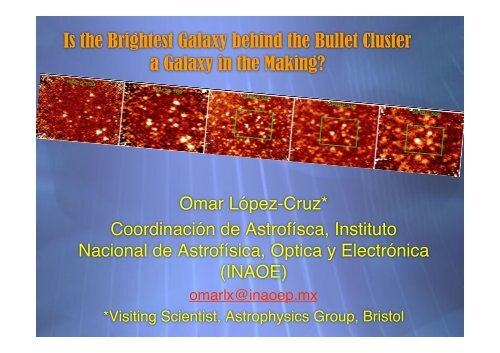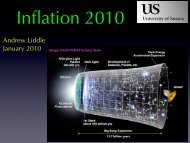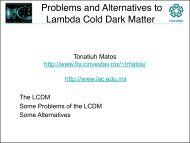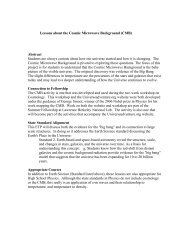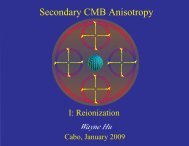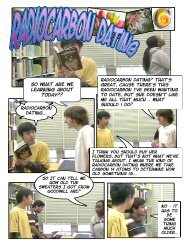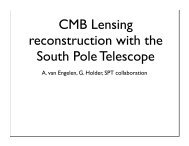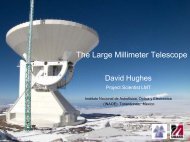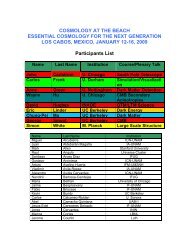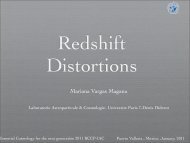Is the Brightest Galaxy behind the Bullet Cluster a Galaxy in the ...
Is the Brightest Galaxy behind the Bullet Cluster a Galaxy in the ...
Is the Brightest Galaxy behind the Bullet Cluster a Galaxy in the ...
Create successful ePaper yourself
Turn your PDF publications into a flip-book with our unique Google optimized e-Paper software.
<strong>Is</strong> <strong>the</strong> <strong>Brightest</strong> <strong>Galaxy</strong> <strong>beh<strong>in</strong>d</strong> <strong>the</strong> <strong>Bullet</strong> <strong>Cluster</strong><br />
a <strong>Galaxy</strong> <strong>in</strong> <strong>the</strong> Mak<strong>in</strong>g?<br />
Omar López-Cruz*<br />
Coord<strong>in</strong>ación de Astrofísca, Instituto<br />
Nacional de Astrofísica, Optica y Electrónica<br />
(INAOE)<br />
omarlx@<strong>in</strong>aoep.mx<br />
*Visit<strong>in</strong>g Scientist, Astrophysics Group, Bristol
The Team<br />
Mark Birk<strong>in</strong>shaw, Malcolm Bremer, Kathy Lancaster<br />
at Bristol University, UK<br />
Frank Bertoldi, K. Basu, M.W. Sommer & Padeli<br />
Papadopoulos at Argelander-Institute für Astronomie,<br />
Germany<br />
Kathy Horellou, Daniel Johansson (PhD 2011),<br />
Sebastian Muller, and John H. Black at Chalmers<br />
University of Technology, Sweden<br />
Omar López-Cruz, Olga Vega, W. F. Wall, Héctor J.<br />
Ibarra-Medel and Edgar Castillo-Dom<strong>in</strong>guez at<br />
INAOE<br />
Hernán Qu<strong>in</strong>tana at PUC, Chile
Science<br />
The results to be presented <strong>in</strong> this talk<br />
come from three publications:<br />
Johansson, D., Horellou, C., Sommer,<br />
M.~W., et al. 2010, A&A, 514, A77<br />
Johansson, D., Horellou, C., López-<br />
Cruz, et al, 2012, to be published <strong>in</strong><br />
A&A<br />
López-Cruz et al. 2012 (<strong>in</strong><br />
preparation)
The <strong>Bullet</strong> <strong>Cluster</strong> (1E 0657 -57) was discovered by Tucker et al. (1995) us<strong>in</strong>g E<strong>in</strong>ste<strong>in</strong> IPC.<br />
Tucker et al. (1998) used ASCA data and derived T= 17 keV (5.2 X 10 8 K), one of <strong>the</strong> hottest<br />
known cluster. Established as a cluster-cluster merger by Tucker et al. (1998a) us<strong>in</strong>g<br />
ROSAT. The most lum<strong>in</strong>ous synchrotron radio halo (Liang et al. 2000). Supersonic merger<br />
Mach=2-3 shock: v=4000-5000 km/s (Markevitch et al. 2002)
Physical Properties of <strong>the</strong> gas <strong>in</strong> <strong>the</strong> <strong>Bullet</strong><br />
<strong>Cluster</strong> (Markevitch et al. ,2002)
Liang et al. (2000)<br />
1.3 GHz ATCA<br />
observations
The 17 sources detected by APEX/LABOCA 850µm<br />
observations. The black contour shows <strong>the</strong> 2 mJy/beam level.<br />
The red <strong>in</strong>ner dashed circle marks <strong>the</strong> 10 arcm<strong>in</strong> used for<br />
analysis ( ~1.3, Rex et al. 2010). (185 scans/8 m<strong>in</strong> <strong>in</strong>t.)<br />
Johansson et al. 2010, A&A, 514, A77
Johansson et al. 2010, A&A, 514, A77
APEX+LABOCA
The bullet has <strong>the</strong> most<br />
lensed galaxies<br />
<strong>Cluster</strong>s observed with<br />
APEX/LABOCA by<br />
Johansson,Sigurdarson<br />
and Horellou (2011)
Bradac et al., 2009<br />
Gonzalez et al. 2009
tmp/PreviewPasteboardItems/RawleHerschelbu
CO redshifts for SMG
Gonzalez et al. 2010 PAH redshift, z=2.791 +/- 0.007<br />
CO(3-2) 91.23 GHz; CO(1-0) 30.41 GHZ
CABB
The first 3mm CABB channel map. Observed on<br />
October 17-18, 2010 with ATCA
(Solomon & Vanden Bout 2005)
z co=2.7795 +/- 0.0010 CO(3-2)/CO(1-0)=0.56<br />
Components<br />
at <strong>the</strong> same z;<br />
hence, we are<br />
deal<strong>in</strong>g with a<br />
s<strong>in</strong>gle galaxy.
Gas Mass and Dynamical<br />
CO-H 2 conversion.<br />
Tak<strong>in</strong>g<br />
Mass<br />
Formula by Papadopoulos et al. 2000; tak<strong>in</strong>g = 0.5; L = 2 kpc
Dust Temperature<br />
T= 32.7 +\- 5.0 K<br />
M dust=1.7X10 7 M
Comparison with o<strong>the</strong>r highly<br />
magnify galaxies
SMG are usually ULIRGS<br />
Michalowski et al. 2010
Michalowski et al. 2010
SMM J0658 SED<br />
Published observation, modeled with GRASIL <strong>in</strong> progress
Conclusions<br />
<strong>Cluster</strong>s of galaxies act<strong>in</strong>g as natural telescopes<br />
allow us to study <strong>in</strong>tr<strong>in</strong>sically fa<strong>in</strong>t SMG.<br />
We have detected CO for <strong>the</strong> first time us<strong>in</strong>g<br />
ATCA/CABB. We have ref<strong>in</strong>ed on <strong>the</strong> redshift on<br />
<strong>the</strong> brightest SMG <strong>beh<strong>in</strong>d</strong> <strong>the</strong> bullet cluster.<br />
The derived masses are consistent with galaxies<br />
smaller than <strong>the</strong> Milky Way. SMM J0658 is an<br />
starburst<strong>in</strong>g young galaxy. It may be more<br />
representative of <strong>the</strong> overall population of galaxies<br />
at z ~3.<br />
Observations with ALMA will allow us to impose<br />
tighter constra<strong>in</strong>s on <strong>the</strong> physical properties of this<br />
ra<strong>the</strong>r <strong>in</strong>terest<strong>in</strong>g low-mass galaxy.


